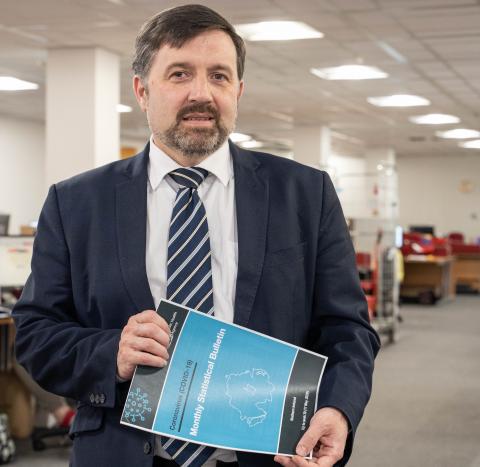PHA publishes first monthly coronavirus bulletin

The Public Health Agency (PHA) has developed a new report examining key trends and characteristics of COVID-19 (coronavirus) in Northern Ireland to help build a longer-term understanding of the virus and its impact. The report will be published on a monthly basis as we move through the pandemic.
Health Minister Robin Swann MLA said: “Throughout this pandemic there has been an understandable focus on statistics and percentages, and I have always been determined to ensure that there is the maximum possible transparency. The data helps us to track and understand the virus and its impact both on the community and the health and social care system.
“The statistics also tell a human story of how the virus has left its tragic mark on families and communities who have lost loved ones. The valuable and detailed analysis contained within the monthly bulletin will help us to develop our plans for the vital recovery period as we start to re-engage our health and social care services.”
Professor Hugo Van Woerden, Director of Public Health at the PHA, said: “Coronavirus is a global issue having a local impact on everyone’s lives. While the primary focus to date has been the significant effort to reduce the spread of the virus and save lives, we are now at a point where we can start to examine the particular ways it is affecting people living in Northern Ireland and our health service.
“In particular, we have been able to study the demographic characteristics, such as age, sex, geographical location and deprivation, of people affected by the virus. The report also looks at some of the wider impact of the virus on the healthcare system, comparing recent trends in activity with historic norms.
“While there is a large amount of data being regularly published on coronavirus, such as through the Department of Health dashboard and NISRA bulletins, this report aims to monitor key trends in COVID-19 activity in Northern Ireland and complements the range of existing data currently available.
“As this is an emerging pandemic the systems used will constantly evolve and the complexity of the analysis will increase.”
The report shows that up to week 20 (17 May 2020), for example, there were 4,469 laboratory-confirmed cases, with 61% of total cases being female. 28% of total cases reside in Belfast (Local Government District).
In addition, 71 samples from the flu spotter programme were tested retrospectively (swabbed 27 December 2019 - 12 March 2020). None were positive for the virus: 96% were negative and the other 4% did not have sufficient sample remaining to be tested. This would suggest that the virus was not circulating undetected in Northern Ireland before the first case was confirmed.
This surveillance will help inform the ongoing response to coronavirus and how Health and Social Care plans for the future.
The surveillance report is available at www.pha.site/cvstats
A flu spotter is a GP practice that undertakes enhanced surveillance in partnership with the PHA during the flu season. These practices represent 11% of the NI population and perform an essential role informing community disease activity. This network has been adapted for COVID-19 surveillance.
